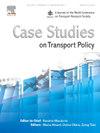Evaluation of Equivalent Property Damage Only (EPDO) weight sets for hotspot identification: A case study on Korean expressways
IF 3.3
Q3 TRANSPORTATION
引用次数: 0
Abstract
The Equivalent Property Damage Only (EPDO) method, which assigns weights to different crash severities: fatal, severe injury, minor injury, and Property Damage Only (PDO) crashes, is widely used for hotspot identification. Determining appropriate EPDO weight sets is crucial, since incorrectly specified weight sets can misidentify hotspots and undermine safety interventions. However, existing EPDO weight sets are largely crash-cost-based or internally determined ratios, lacking empirical validation. To fill this gap, this study proposes a data-driven framework that systematically generates and evaluates EPDO weight sets using Korean expressway crash data. For multiple EPDO weight sets, we identify the top 1% to 10% of hotspots for each weight set using these data. The performance of the EPDO weight sets is evaluated by examining the numbers of (i) fatal, (ii) non-PDO (i.e., including fatal and injury crashes), and (iii) total crashes that occurred at those hotspots in the subsequent year. Based on these three criteria, we derive Pareto EPDO weight sets. The results indicate that assigning higher weights to non-PDO compared to PDO crashes, using weights smaller than typical cost-based values, leads to more accurate identification of hotspots in terms of both fatal and casualty crashes. Conversely, assigning identical weights across severities best predicts total crashes. This framework enables practitioners and policymakers to recalibrate EPDO weight sets to local conditions, improving the allocation of limited safety resources.
用于热点识别的等效财产损失(EPDO)权重集评价——以韩国高速公路为例
EPDO (Equivalent Property Damage Only)方法是一种被广泛应用于热点识别的方法,该方法对致命、重伤、轻伤和PDO (Property Damage Only)碰撞等不同的碰撞严重程度分配权重。确定适当的EPDO权重集是至关重要的,因为不正确指定的权重集可能会错误识别热点并破坏安全干预措施。然而,现有的EPDO权重集主要是基于碰撞成本或内部确定的比率,缺乏经验验证。为了填补这一空白,本研究提出了一个数据驱动的框架,该框架使用韩国高速公路碰撞数据系统地生成和评估EPDO权重集。对于多个EPDO权重集,我们使用这些数据确定每个权重集的前1%到10%的热点。EPDO权重集的性能是通过检查(i)致命,(ii)非pdo(即,包括致命和伤害事故),以及(iii)在这些热点地区在随后的一年发生的总事故的数量来评估的。基于这三个准则,我们导出了Pareto EPDO权值集。结果表明,与PDO碰撞相比,赋予非PDO更高的权重,使用比典型的基于成本的值更小的权重,可以更准确地识别致命和人员伤亡事故的热点。相反,在严重程度上分配相同的权重可以最好地预测总崩溃。该框架使从业者和政策制定者能够根据当地情况重新校准EPDO权重集,从而改善有限安全资源的分配。
本文章由计算机程序翻译,如有差异,请以英文原文为准。
求助全文
约1分钟内获得全文
求助全文

 求助内容:
求助内容: 应助结果提醒方式:
应助结果提醒方式:


